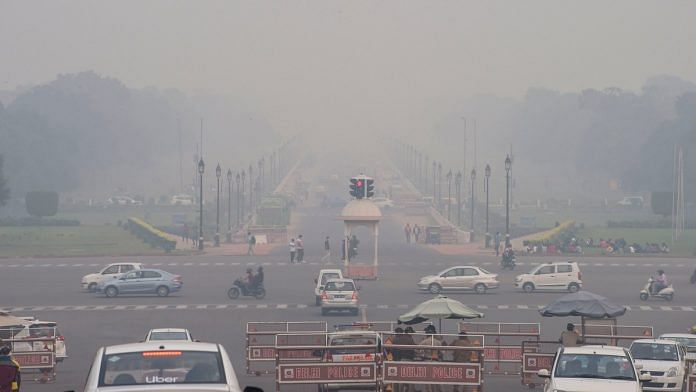New Delhi: Air pollution caused more than 16.7 lakh deaths in India in 2019 — over ten times more than the country’s Covid-19 death toll so far — causing economic losses of nearly $36.8 billion (Rs 2,71,446 crore), according to a study published in The Lancet Planetary Health journal.
The study, conducted by researchers from AIIMS, ICMR and IIT-Delhi and titled ‘Global Burden of Disease Study, 2019’, measured the economic impact of air pollution, both indoor and outdoor, as it caused loss of output due to premature deaths and morbidity.
These deaths account for 17.8 per cent of the total deaths in the country last year, while the economic losses amounted to 1.36 per cent of India’s total gross domestic product (GDP), stated the study published Tuesday.
The researchers said that while the association of air pollution with multiple adverse health outcomes is well established, its economic impact is less understood. It is important to elucidate this economic impact for the states of India, the researchers wrote in the study.
The team, which also included contributors from institutes like CSIR and PGIMER, estimated the amount of exposure to ambient particulate matter pollution, household air pollution and ambient ozone pollution, as well as their attributable deaths in every state of India.
The economic impact of air pollution was also estimated for every state of India.
“Improved methods in this paper have led to a higher estimate of the impact of air pollution on health and disease in India than previously estimated. The health and economic impact of air pollution is highest in the less developed states of India, an inequity that should be addressed,” said Lalit Dandona, National Chair of Population Health at ICMR and senior author of this paper, in a statement.
Also read: Morning after Diwali, Delhi air quality ‘severe’ but better than last year’s, relief likely
Deaths attributable to air pollution
The majority of deaths due to pollution were linked to ambient particulate matter pollution and household air pollution.
However, the team found that death rate due to household air pollution decreased by 64.2 per cent from 1990 to 2019, while deaths due to ambient particulate matter pollution increased by 115.3 per cent in the same period. Deaths due to ambient ozone pollution increased by a whopping 139.2 per cent, according to the study.
“Various government schemes such as the Pradhan Mantri Ujjwala Yojana and the Unnat Chulha Abhiyan have aided in reducing household air pollution in India, the benefits of which are suggested in the reducing death rate from it as seen in this paper,” said Balram Bhargava, director-general, ICMR, in the statement.
“Such success encourages us to enhance efforts to reduce outdoor air pollution as well,” he said.
The report also pointed out that while 40 per cent of the disease burden due to air pollution is from lung diseases, the remaining 60 per cent is from heart disease, stroke, diabetes, and neonatal deaths.
“This highlights that air pollution had a broad ranging impact on human health,” Bhargava added.
Economic losses
The economic loss due to premature deaths amounted to $28.8 billion (Rs 2,12,436 crore), said the study, adding that losses due to diseases in the population attributable to air pollution accounted for $8 billion (Rs 59,010 crore).
These losses amount to nearly 1.36 per cent of India’s GDP, but it varied widely at the state level.
For example, Delhi had the highest per capita economic loss of $62 (Rs 4,573) due to air pollution.
Economic losses were highest in states where the per capita GDP is already low, such as Uttar Pradesh, Bihar, Rajasthan, Madhya Pradesh and Chhattisgarh.
Total economic losses attributable to air pollution was the highest in UP, with the state losing an estimated $5,130 million (Rs 37,840 crore) to pollution.
“These estimates of economic loss as a result of air pollution across different states of India provide extremely useful insights to central and state level decision-makers who would find that the investment in pollution control not only yield attractive return in terms of prevention of loss of life, but achieving Sustainable Development Goals (SDGs) of good health, sustainable cities, climate action, social justice and inclusive economic growth, besides others,” said Pushpam Kumar, chief environmental economist, United Nations Environment Programme, in the statement. He had conceptualised the method for economic analysis in this study.
“This landmark study would help the government and private sector for channeling resources for pollution control in the country and, therefore, ensuring the sustainable and inclusive future for India and the world,” Kumar added.
Also read: Delhi’s poor AQI not just a winter problem & why Centre can’t arm-twist Punjab farmers






